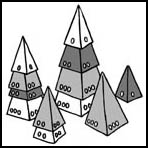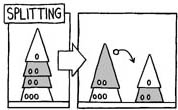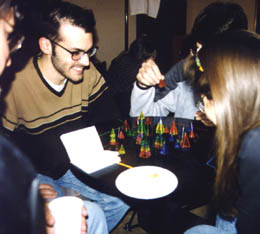 IceTowers
IceTowers
an Icehouse game
designed by Andrew Looney
WHAT YOU NEED
- Additional equipment: none
- Number of players: 2-4 (best with 3 or 4)
- Playing time: 5-10 minutes
|
WHAT YOU NEED
|
New! Playing with Gus
OVERVIEW
IceTowers is a high-speed game of pyramid stacking, played
without turns on any flat surface. Everyone plays at once, by
"capping" other pieces with those of their own color.
If yours is the top piece on a tower at the end of the game, you
get points for the whole tower. As towers grow taller, you'll
be able to "mine" pieces out and replay them, or even
"split" some towers in two. The game ends when no more
plays are possible.
SETUP
Randomly scatter a set of Icehouse pieces across the tabletop,
then stand them all upright where they lie. Assign a color to
each player.
PLAY OPTIONS
| Capping: Stacking one of your pieces up on someone else's to take control of it is the most common action in this game. You may only pick up and move freestanding pieces of your own color. In order to cap, your piece must be the same size or smaller and a different color than the piece you are capping. |
 |
| Mining: If you don't control a tower (i.e. you don't have the top piece), but two or more of your pieces are inside the tower, you may open up the stack and remove one of your pieces (your choice). Reassemble the rest of the tower and continue playing (but see the No Minebacks rule below). |
 |
| Splitting: Whenever two pieces of any other player's color are next to each other in a tower, you may split the tower in two, by separating the pair of same-colored pyramids. You cannot split your own pieces; if no one else chooses to do so, a tower may remain unsplit. |
 |
RESTRICTIONS
No Turns: IceTowers is unlike most games in that everyone
plays all at once there's no waiting for your turn. As soon
as everyone is ready, you can start playing. You may carry out
any of the three options for play at any time you choose.
No Two-Handed Play: Sometimes it will be necessary to use both hands (notably when mining), but as a rule, you can only use one hand while playing this game. In other words, you can only conduct one play option at a time.
No Minebacks: When you mine out a piece, you must immediately use it to cap a different tower. If there are no legal plays available, you must set the piece down in the open. (Etiquette note: it's acceptable to take a moment to examine your options, but you should then come to a decision and play the piece. You can't sit holding onto it, waiting for something better to come up; indeed, others may insist that you play the piece before they take their next actions.)
 ENDING
THE GAME
ENDING
THE GAME
The game ends when all players agree that no more plays will
be made. Often this will happen automatically, when no more moves
are possible, but generally the players will need to agree that
the game is over, since not all Splitting opportunities need be
taken advantage of. Also, games may sometimes terminate due to
a stalemate condition (see below).
SCORING
When the game is over, collect up all the towers you control
and put them in front of you. You get three points for each large
piece you end up with, two points for each medium, and one point
for each small piece. The player with the highest score wins.
STALEMATE CONDITIONS
During the endgame, a couple of forms of deadlock are possible
(although unlikely). If a stalemate situation arises, the game
is ended and the deadlocked pieces are dealt with as described
below.
Final Piece Showdown: At the end of the game, you could wind up with an unplayed piece in your hand and nowhere attractive to put it. If there's someone else in the same situation, neither of you will want to set down your last piece, for fear of it being capped by the other player. In this case, the game ends and the players just set their pieces down. Pieces left free-standing in this way are scored as usual.
Tower Wars: Occasionally, an infinite loop situation may arise, in which several players can mine pieces and use them to take control of other towers, in a way that seems unending. Should this occur, the first thing to do is to keep playing for a while longer, since an ending may still be possible.
Think of it as a puzzle, and seek out the solution. For example, look for a chance to mine out a piece that will cause two pieces of one color to come together, thus allowing you to split the tower and break up the situation. If no resolution can be found to a Tower War, however, the game terminates and all towers involved in the war are removed, scoring no points.
TWO-PLAYER OPTION
IceTowers is best when played by three or four players, but it
can also be played with two. Each person plays two colors. The
game proceeds as if there were four people in the game, with each
player carrying out actions for both of the colors they are assigned.
At the end, you get points for towers controlled by both of your
colors, the winner being the player with the highest combined
score.
The two colors assigned to a player are still considered to be distinct, while the person who plays them is considered to be a single player. You may cap one of your colors with the other. You can mine one color out of a tower controlled by your other color. In order to split, two adjacent pieces must still be the same color, but only your opponent can split pairs in either of your colors.
![]() STRATEGIES
STRATEGIES
Start Big: The most powerful pieces in the game are
the 1-pointers, which can be used to capture anything, so save
them until the end. Play the 3-pointers first.
Invest in the Future: Set up mining opportunities for yourself
by getting a piece in on the lower levels of a tower. Later, if
you cap that tower with a small piece, you'll have a lock on it,
since you'll be able to mine the piece out again if someone else
caps you.
Limit Your Opponents' Options: By the same token, if you cap towers indiscriminately, you'll just create mining opportunities for others. Look for towers in which the top piece is the only one of its color, and be especially careful not to cap a tower in a way that allows someone else to mine out more than one piece.
Look Before You Mine: The No Minebacks rule requires you to replay what you mine without too much delay, so figure out what you'll do with a mined piece before you get it into your hand.
Mine With Splitting in Mind: Splitting a tower can often stop your opponent cold, so watch for chances to remove a piece that will create a splitting situation. But don't split up a pair at the top of a tower... you'll just be giving another player a free piece.
|
When you need an extra player, just summon up a ghost! Here's a way for 2 people to play IceTowers using just 3 Icehouse stashes: pretend you have another player! His name is Gus and he just happens to be a ghost. Since he has no physical form, he can only move his pieces by mentally commanding the other players to make his moves for him.
Begin by selecting a color for Gus to use. He can be any color, but Gus prefers White. (His second choice is Clear.) Either player may move for Gus at any time, with the following restrictions:
And yes, if Gus gets the highest score, he is the winner! Why the name Gus? It's a nod to the ghostly main character of a series of children's books written by Jane Thayer and illustrated by Seymour Fleishman. Among many other things, Gus is a game-playing ghost, who is seen playing checkers with Mouse in the first book of the series, Gus was a Friendly Ghost, originally published in 1961. |